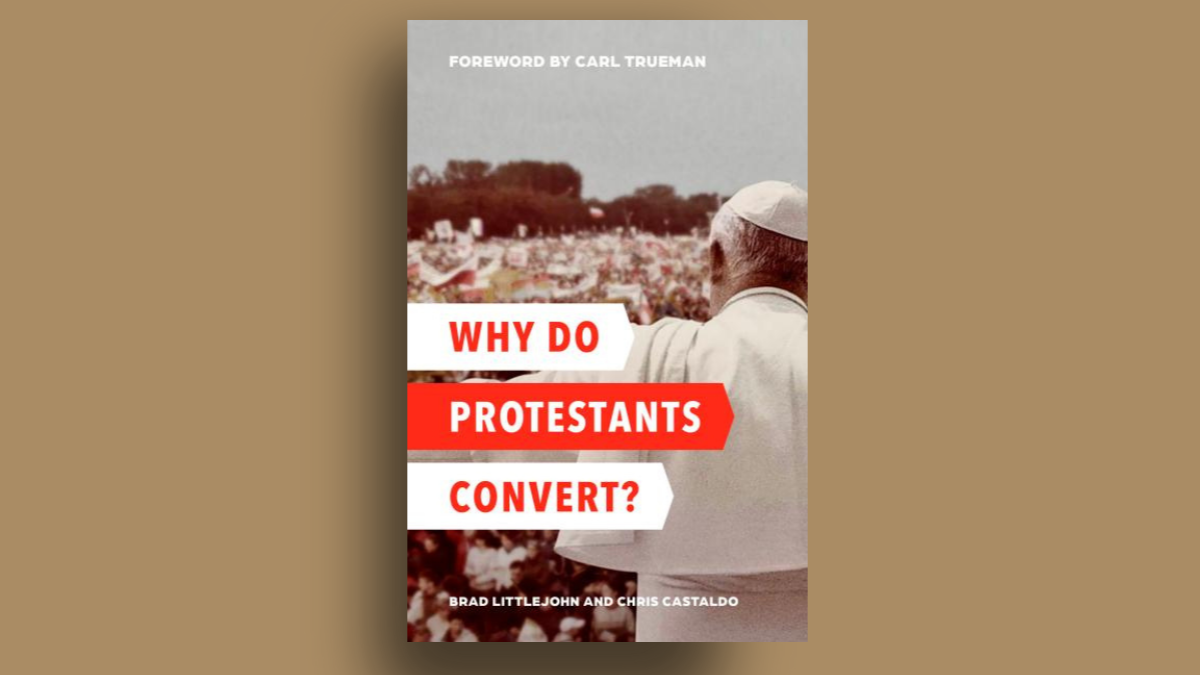Why Do Protestants Convert? should be read by many, even though it may please few. Coauthored by Brad Littlejohn (a colleague of mine at the Ethics and Public Policy Center) and Chris Castaldo, this slim volume regards conversion holistically, as a process involving the whole person, rather than only a matter of dueling theological propositions.
Consequently, the authors’ answers to the question in their title may irritate everyone. Protestants may feel excessively criticized while Catholic readers may complain that the authors’ sociological and psychological focus avoids serious engagement with Catholic theology. But there was no need for another book arguing over theology. Conversions rarely begin from theological contemplation, but from a sense that Protestantism lacks something Catholicism has. Thus, explaining why Protestants, and especially so many of their “best and brightest,” convert requires examining the failures of modern American Protestantism.
The basic problem is, as Carl Trueman observed in a brief forward, that “the idiom of the rock concert with added TED talk is scarcely adequate to convey the holiness of God, the beauty of worship and the seriousness of the Christian faith.” Generations of evangelical leaders have embraced the idea that casual, entertaining, “seeker-sensitive” church services are the key to a growing congregation. Some succeed, but they leave a lot behind in the attempt. This is why it often seems that nearly every intellectually or aesthetically sensitive American evangelical will at some point feel the allure of Catholicism — the road to Rome often begins with a sense that one’s Protestant church is missing something important, if not several things.
For the sake of analysis, Littlejohn and Castaldo try to separate the motives for conversion, even while recognizing that they will inevitably be intermingled in the psyche and conversion process. They group these factors into triads and begin with the “psychology of conversion,” observing that Catholicism offers paternal authority “in an age that has all but blacklisted the very word” and that “precious few of our Protestant churches give their worshippers a sense of being in the presence of the holy.”
Instead, evangelicals in particular are encouraged to “waltz casually” before God “with gym shorts and a latte.” It is no wonder that some are “captivated” when they witness the Catholic Mass, along with the rest of the aesthetic heritage of the Church of Rome — even when wealthy evangelical congregations build large churches, they look like convention centers, not cathedrals.
And to the promises of real authority, and reverential worship aided by real beauty, Catholicism adds intellectual and cultural sophistication absent from much of the evangelical world. For example, Catholics are overrepresented in conservative legal and intellectual circles. In such circumstances, conversion may also seem like a route to belonging and even status.
A point that might have been fruitfully drawn out more is that potential converts are disproportionately exposed to what is best in Catholicism. Encountering Catholicism through the sort of devout, intellectual, and artistic circles the authors describe obscures and blunts the reality of much of modern American Catholicism. The hospitality, warmth, and beauty that such circles offer are precious, but that is not the norm for American Catholic life, which is full of plenty of other parishes that function as sacrament factories with terrible preaching and little community, to say nothing of the apostasy and scandals that plague the Church of Rome. Consequently, potential converts should reckon with the disappointing realities of American Catholicism outside of the rarified circles of the conservative Catholic elite.
The authors next turn to how Catholic theological claims appeal to converts, highlighting Rome’s promises of certainty, historical continuity, and a sacramental life with tangible sources of grace. Each of these fills gaps common to American evangelicalism.
To those unsettled by the prospect of trusting nothing more than their private interpretation and the disparate interpretations of a plethora of ill-educated evangelical leaders and influencers, Catholicism offers certainty, with the weight of tradition behind it. Likewise, Catholic tradition provides a sense of the continuity of the faith that many Protestants crave in contrast to the numerous pastors and teachers who essentially ignore Christian teaching and history between around 90 A.D. and sometime in the 20th century, and the many who regard the majority of Christian history as essentially an extended festival of heresy.
Evangelical converts also appreciate Catholicism’s sacramental focus. For example, the Catholic reverence for the Eucharist is a stark contrast to an evangelical culture in which communion, for example, is just a symbol that is poorly explained, infrequently administered, and irreverently received.
Littlejohn and Castaldo conclude their tour of conversion motivations by surveying sociological factors. For those weary of division, Catholicism offers unity. For those sick of shallowness, it promises depth. And for those exhausted by irrelevance, its institutional and intellectual power promises importance and effective action. That these echo prior points illustrates how the different angles of investigation chosen by the authors keep finding the same core reasons for conversion.
Their conclusion is that Protestants convert because of Protestant failures. For Catholics, these failures are evidence of the fundamental deficiencies of Protestantism, but for Protestants such as Littlejohn and Castaldo, they are an urgent warning demanding renewal. Thus, the core audience for this book is not so much potential converts as Protestant pastors and other leaders who can help remedy the deficiencies of American Protestantism.
The authors insist that the Reformed tradition has the resources to fill the holes that are leading many of Protestantism’s “best and brightest” to look toward Rome. The book reminds readers that, “Far from trying to break with tradition, the Reformers were seeking to recover it, a legacy that we must recapture and emulate in our own day.” Protestant worship can be beautiful, reverent, liturgical, and sacramental. Protestant preaching and teaching can be authoritative, intellectually formidable, and historically informed.
The Reformed heritage can meet the needs that lead many to look toward Rome. But this will require leaders who want to maintain and develop their spiritual patrimony, rather than chasing the latest trends. As Littlejohn and Castaldo bluntly put it, evangelical churches need to follow the Reformers’ example in trying to carefully balance “Word and Sacraments in worship, bringing together mind and heart, soul and body, individual and community” rather than focusing on the “right balance of Coffee Hour and Praise Band Hour.” Harsh, but fair.
The authors’ admonitions regarding why Protestants should not convert are less helpful, though it is understandable why they wanted to include them. But these arguments, shoved in at the ends of chapters and in a short afterward, are brusque to the point of being counterproductive. Forceful but underdeveloped denunciations of Catholic doctrine and practice are unlikely to win back those considering conversion. This book is not the right place for those debates.
Nonetheless, Littlejohn and Castaldo have succeeded in providing a concise and compelling account of how the failures of Protestant churches are leading some to Rome. The diagnosis may be painful, but in providing it, they have outlined the road to renewing and revitalizing the Reformed tradition and American evangelicalism.









